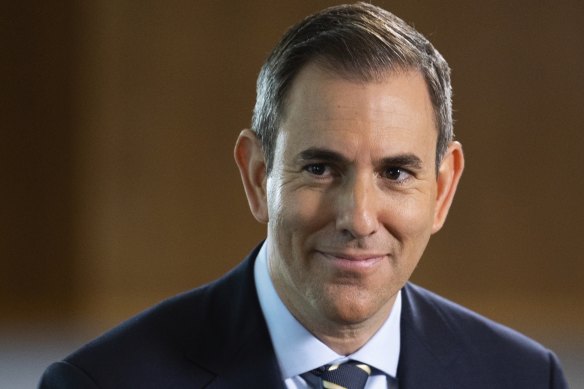Save articles for later
Add articles to your saved list and come back to them any time.
A revenue surge has lifted the nation’s finances to a $4 billion surplus this year after helping to pay for new spending measures that offer financial help to millions of households, marking a dramatic turnaround in the federal budget and escalating a political clash over economic management.
Treasurer Jim Chalmers will confirm the surplus in the budget on Tuesday night with a crucial pledge to save the vast majority of the upgrade in the revenue forecasts, which will shrink deficits by a stunning $143 billion over the next four years.
Treasurer Dr Jim Chalmers is all smiles ahead of the budget, which will show a surplus.Credit: Alex Ellinghausen
Days after Coalition treasury spokesman Angus Taylor claimed a “drover’s dog” could deliver a surplus, Chalmers will point to federal cabinet decisions to save money as proof that Labor has achieved a major fiscal repair that eluded the Coalition during its nine years in power.
The forecast for this year represents a calculated risk by Chalmers and his cabinet colleagues, given the danger of an unforeseen event that overturns the assumptions, but it is being made with a high degree of confidence because the end of the financial year is only seven weeks away.
The surplus will contrast with the Coalition forecast for a $78 billion deficit for the same year in the budget released just before the last election, highlighting the scale of the revenue gains from stronger employment and high prices for coal, iron ore, gas and other exports.
But the pressure on the federal finances will return next year because commodity prices are expected to fall and the budget will sink into deficits again unless the tax forecasts are proven wrong or the government embarks on major changes such as rethinking the stage three tax cuts or launching controversial cuts to spending.
Chalmers said the government was taking a “cautious, careful and conservative” approach to forecasting a surplus and declared there would be no “back in black mugs” – a reference to Liberal Party merchandise that celebrated a surplus before the pandemic swept away the positive forecasts.
“This is a dramatic and unprecedented turnaround from the $78 billion deficit we inherited,” Chalmers said.
“The government is returning 82 per cent of revenue upgrades in this budget and 87 per cent across our first two budgets to the bottom line.”
In a central political claim, Chalmers said Labor would save more of its revenue upgrades than the Coalition did in the last government, which he said only returned 40 per cent of the gains to the budget bottom line.
But the Coalition is turning its focus on the economic objective of fighting inflation and preparing to oppose new initiatives such as a $1.9 billion increase in help for single mothers announced by Prime Minister Anthony Albanese in Perth on Monday.
“Look, a drover’s dog can deliver a budget surplus this year,” Taylor said on Sunday.
“So the government’s inherited this situation and they can deliver that in the short term. The real test is can they deliver budget balance on an ongoing basis because that will take pressure off and the key to that is not taxing more.”
“A drover’s dog can deliver a budget surplus this year,” says shadow treasurer Angus Taylor.Credit: Alex Ellinghausen
With inflation at 7 per cent, the Coalition has named the cost of living rather than the surplus as the priority for the budget, saying Labor should manage spending and prevent consumer prices rising further.
The budget appears unlikely to cut spending in net terms but Finance Minister Katy Gallagher confirmed on Monday it would include savings worth $17.8 billion in order to help fund other policies, citing this as proof that Labor was being responsible with taxpayer funds.
As well as the automatic revenue gains from factors outside the government’s control, the budget will include $3.3 billion in higher taxes on tobacco and $2.4 billion in higher taxes on oil and gas over the next four years to help pay for new spending measures.
The new outlays include the $14.6 billion package to help households with cost-of-living pressures such as the price of energy and medicines, as reported by this masthead on Monday, as well as more income support for those in need, such as single mothers.
The previous government forecast deficits worth $224.7 billion over the four years to 2026 when it released its March budget before going to the election last year.
Chalmers will reveal a turnaround in the nation’s finances over the same four years to shrink those deficits by $143 billion.
This means the deficits over the next four years would be worth about $82 billion, a far better outlook than any budget since the pandemic, but highlighting the way the nation’s finances will return to red ink after a single year of surplus.
Cut through the noise of federal politics with news, views and expert analysis from Jacqueline Maley. Subscribers can sign up to our weekly Inside Politics newsletter here.
Most Viewed in Politics
From our partners
Source: Read Full Article


